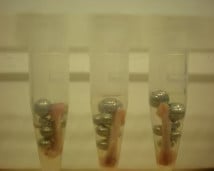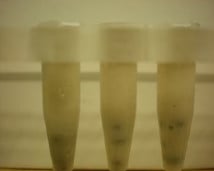What Bead Lysis Kit is right for my research?
Here are some recommendations and guidelines to keep in mind when selecting a Bead Lysis Kit to use. If you have any questions, or need help selecting a kit, please don’t hesitate to contact us.
The main things to consider are your desired buffer volume and the toughness of your sample. Pink and Red kits are best for soft samples, Green and Navy for tougher material, and Yellow kits are used to lyse bacteria. Pink and Green kits are appropriate for buffer volumes up to 200 μL; Red, Navy and Yellow kits can be used for volumes between 200 and 500 μL.
Note that Bead Lysis Kits are not appropriate for all samples. For special applications such as extracting live bacteria from tissue, grinding dry agricultural samples, or tissue dissociation, we recommend bulk beads. See the Protocols page for suggestions, or contact customer support so we can help you determine the best way to process your sample.
Kits for specific sample types
Consult the table below to identify the best kit for your sample. You can also search our homogenization protocols for your exact sample type; kit recommendations are included.
Find your sample type: Animal tissue | Plant matter | Cell culture | Small organisms
|
Sample Size and Buffer Volume |
Bead Lysis Kits |
|
Animal Tissue |
||
|---|---|---|
| Soft to medium samples such as brain, liver, kidney | up to 200 µL of buffer, samples up to 100 mg | PINK, GREEN |
| 200 µL to 600 µL of buffer, samples up to 300 mg | RED, NAVY | |
| Tough samples such as tumor or cardiac muscle | up to 200 µL of buffer, samples up to 100 mg | GREEN |
| 200 µL to 600 µL of buffer, samples up to 300 mg | NAVY | |
| Very tough samples such as bone, skin, or connective tissue | 200 µL to 600 µL of buffer, samples up to 200 mg | NAVY |
| Extremely resilient samples such as umbilical cord | Try our UFO beads. | |
Plant Matter |
||
| Soft leaves like Arabidopsis or spinach | up to 200 µL of buffer, samples up to 100 mg | PINK, GREEN |
| 200 µL to 600 µL of buffer, samples up to 300 mg | RED, NAVY | |
| Tough leaves like oak, fruit, slender stems, roots | up to 200 µL of buffer, samples up to 50 mg | GREEN |
| 200 µL to 600 µL of buffer, samples up to 200 mg | NAVY | |
| Small or soft seeds, rice grains | 200 µL to 600 µL of buffer, samples up to 150 mg | NAVY |
| Soft macroalgae(e.g., Codium) | up to 200 µL of buffer, samples up to 100 mg | PINK, GREEN |
| 200 µL to 600 µL of buffer, samples up to 300 mg | RED, NAVY | |
| Filamentous or tough algae (e.g., Pithophera) | up to 200 µL of buffer, samples up to 50 mg | GREEN |
| 200 µL to 600 µL of buffer, samples up to 200 mg | NAVY | |
| Very hard seeds, such as dried soy, corn, etc. | Try our Bullet Blender Storm 5 with special beads. Ask us for details. | |
Cell Culture |
||
| Bacteria | 200 µL to 600 µL of buffer, pellets up to 300 µL | YELLOW |
| Mammalian tissue culture | up to 200 µL of buffer, pellets up to 100 µL | PINK |
| 200 µL to 600 µL of buffer, pellets up to 300 µL | RED | |
| Yeast | up to 200 µL of buffer, pellets up to 100 µL | PINK |
| 200 µL to 600 µL of buffer, pellets up to 300 µL | RED | |
| Microalgae (e.g., Haematococcus) | up to 200 µL of buffer, pellets up to 100 µL | PINK |
| 200 µL to 600 µL of buffer, pellets up to 300 µL | RED | |
Small Organisms |
||
| Insects: soft-bodied insects such as fruit flies and honeybees | up to 200 µL of buffer, samples up to 100 mg | PINK, GREEN |
| 200 µL to 600 µL of buffer, samples up to 300 mg | RED, NAVY | |
| Insects: Hard, light insects such as ticks | up to 200 µL of buffer, samples up to 50 mg | GREEN |
| 200 µL to 600 µL of buffer, samples up to 150 mg | NAVY | |
| Nematodes (C. elegans, etc.) | up to 200 µL of buffer, samples up to 100 mg | PINK, GREEN |
| 200 µL to 600 µL of buffer, samples up to 300 mg | RED, NAVY | |
| Zebrafish | up to 200 µL of buffer, larvae up to 100 mg | PINK, GREEN |
| 200 µL to 600 µL of buffer, samples up to 300 mg | RED (larvae only), NAVY | |



